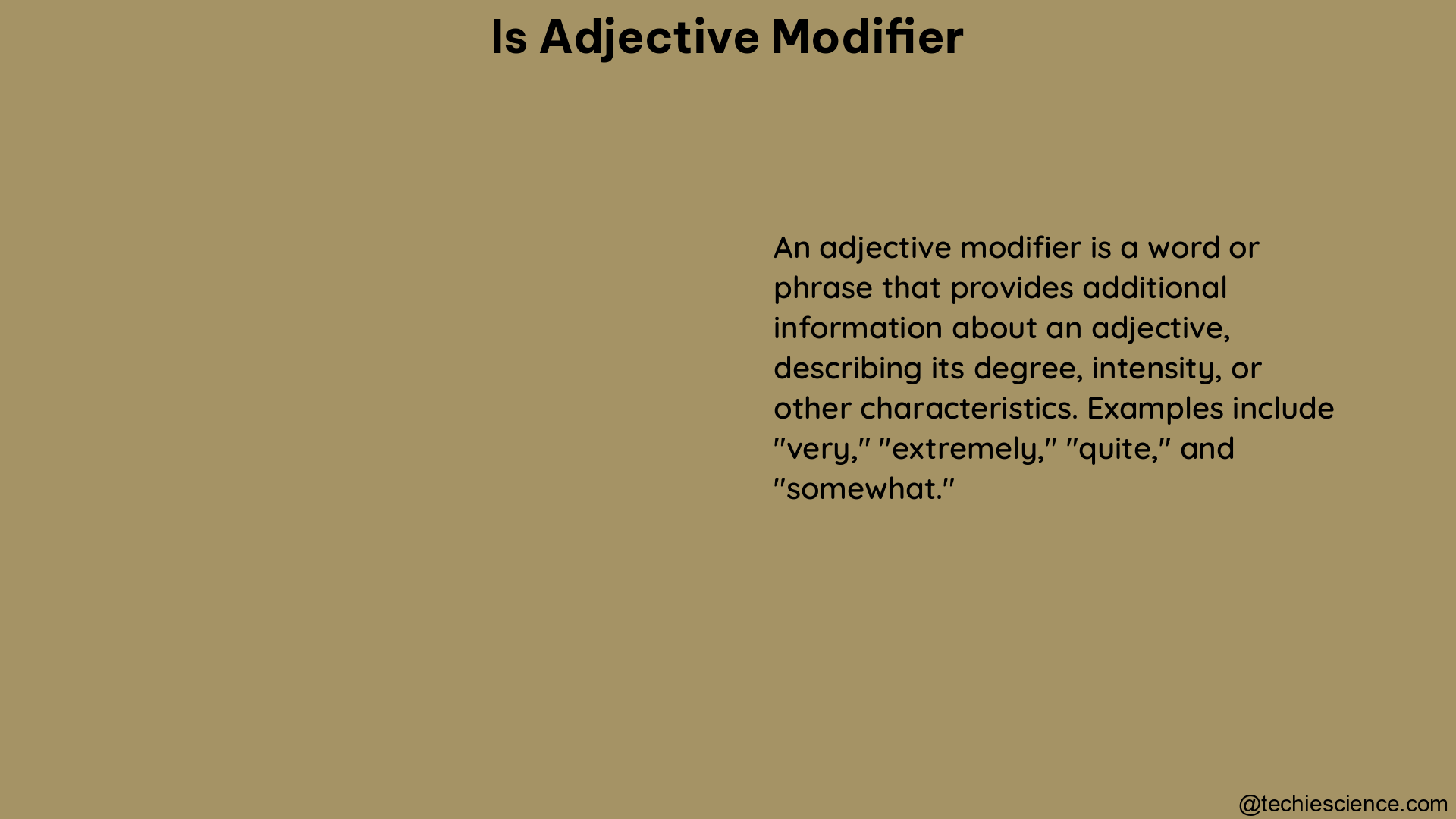Adjective modifiers are a fundamental component of the English language, playing a crucial role in enhancing the descriptive power of our written and spoken communication. These versatile linguistic tools allow us to provide additional details about the nouns and pronouns we use, painting a more vivid and nuanced picture for our audience. In this comprehensive guide, we will delve into the intricacies of adjective modifiers, exploring their various types, their placement within sentences, and the key principles that govern their effective usage.
Understanding Adjective Modifiers
An adjective modifier is a word or phrase that modifies a noun or pronoun, providing additional information about its characteristics, quantity, or identity. Adjectives are a specific type of modifier that directly modify nouns and pronouns, answering questions such as “What kind?”, “Which one?”, and “How many?”. These modifiers can be single words, phrases, or even clauses, and they can be positioned before or after the noun they describe.
Types of Adjective Modifiers

Adjective modifiers come in a variety of forms, each serving a unique purpose in enhancing the descriptive power of our language. Let’s explore the different types of adjective modifiers in detail:
1. Articles
Articles, such as “a,” “an,” and “the,” are a fundamental type of adjective modifier. These words indicate whether a noun is specific or general, helping to establish the context and clarity of the information being conveyed.
2. Titles
Words like “Mr.,” “Mrs.,” “Dr.,” and “Professor” are considered adjective modifiers as they provide information about a person’s title or position.
3. Possessives
Possessive adjectives, such as “my,” “your,” and “his,” indicate ownership or belonging, adding an extra layer of detail to the noun they modify.
4. Comparative Adjectives
Comparative adjectives, like “better,” “taller,” and “more,” allow us to compare the degree of a characteristic between two or more entities.
5. Numerical Adjectives
Numerical adjectives, including words like “nine,” “sixteen,” and “many,” convey information about the quantity or number of the modified noun.
6. Noun Adjectives
In some cases, nouns can be used as adjectives, modifying another noun and providing additional context about its nature or purpose.
7. Demonstrative Adjectives
Words like “this,” “that,” “these,” and “those” are demonstrative adjectives, indicating which specific noun is being referred to.
8. Indefinite Adjectives
Indefinite adjectives, such as “some,” “any,” and “no,” convey non-specific amounts or quantities of the modified noun.
Placement of Adjective Modifiers
Adjective modifiers can be positioned in different ways within a sentence, each placement serving a specific purpose:
Pre-modifiers
Pre-modifiers are adjectives that come before the noun they modify, as in the example: “Suzan gave an outstanding performance in the program.”
Post-modifiers
Post-modifiers are adjectives that come after the noun they modify, as in the example: “Anna is looking gorgeous.”
Adjective Phrases
Adjective phrases are multi-word modifiers that provide additional details about the noun, as in the example: “Alice was reading a novel by Leo Tolstoy.”
Adjective Clauses
Adjective clauses are dependent clauses that modify a noun, as in the example: “The person who helped me in this assignment is Lisa.”
Key Principles of Effective Adjective Modifier Usage
To ensure the optimal use of adjective modifiers in your writing and speech, consider the following key principles:
-
Clarity: Ensure that the adjective modifiers you use clearly and unambiguously convey the intended meaning, avoiding any potential confusion for your audience.
-
Conciseness: Strive to use the most concise and precise adjective modifiers possible, avoiding unnecessary wordiness or redundancy.
-
Variety: Incorporate a diverse range of adjective modifiers in your language to add richness, nuance, and depth to your descriptions.
-
Placement: Pay attention to the placement of your adjective modifiers, ensuring that they are positioned in a way that enhances the overall flow and clarity of your sentences.
-
Consistency: Maintain consistency in the use of adjective modifiers throughout your written or spoken communication, creating a cohesive and polished style.
By mastering the principles of adjective modifier usage, you can elevate your language, captivate your audience, and effectively convey your intended meaning with precision and elegance.
Conclusion
Adjective modifiers are a powerful tool in the English language, allowing us to add depth, nuance, and specificity to our descriptions of the world around us. By understanding the different types of adjective modifiers, their placement within sentences, and the key principles that govern their effective usage, you can unlock a new level of expressive power in your written and spoken communication. Embrace the versatility of adjective modifiers and let them be your guide to crafting more vivid, engaging, and impactful language.
References
- Modifiers – Adjectives and Adverbs by the University of Arkansas. (PDF)
- What Do Adjectives Modify? by Grammarly.
- Examples of Adjectives as Modifiers by LearnGrammar.Net.

Hi…..I’m a graduate with a Bachelor’s degree in English Literature. I wish to do a Masters in the same field someday and continue my career in Academia.
Let’s connect through LinkedIn: